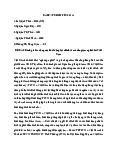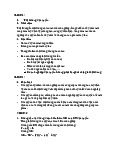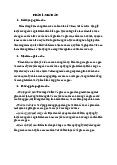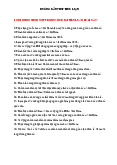


Preview text:
CHAPTER 4/ I.TRUE-FALSE QUESTIONS:
Circle T if the statement is true, F if it is false
1. The business cycle is best defined as alternating periods of increases and decreases in the rate of inflation in
the economy. F – no in the rate of inflation - Real GDP
2. Business cycle tend to be of roughly equal duration and intensity. T – F - unequal
5. The unemployment rate is equal to the number of people in the labor force divided by the number of people
who are unemployed. F – unemployed divided labor force
6. Discouraged workers, those people who are able to work but quit looking for work because they can not find a
job, are counted as unemplyed by the U.S. Bureau of Labor Statistics. F - Aren’t counted/ not in labor force
10. Cyclical unemployment is caused by a decline in total spending. T
16. Inflation is defined as an increase in the total output of an economy.
F – in the general level of prices
17. From one year to the next, the Consumer Price Index rose from 154.5 to 160.5. The rate of inflation was
therefore 6.6%. F – 3.8% - the rate of inflation
18. If the price level increase by 10% each year, the price level will double every 10 years. F – 7 years
19. The essence of demand-pull inflation is “too much spending chasing too few goods”. T
20. Cost-push inflation explains rising prices in terms of factors that increase per-unit production cost. T
21. A person’s real income is the amount of goods and services that the person’s nominal (or money) income will
enable him or her to purchase. T
24. Cost-push inflation reduces real output. T
II. MULTIPLE-CHOICE QUESTIONS
1. Which is one of the four phases of a business cycle ? (a) inflation (b) recession (c) unemployment (d) hyperinflation
3. Production and employment would be least affected by a severe recession in which type of industry?
(a) nondurable consumer goods
(b) durable consumer goods nhiều nhất (c) capital goods (d) labor goods
4. The unemployment rate in an economy is 8%. The total population of the economy is 250 million, and the size
of the civilin labor force is 150 million. The number of employed workers in this economy is (a) 12 milliom (b) 20 milliom (c) 138 milliom (d) 140 milliom
5. The labor force includes those who are
(a) less than 16 years of age
(b) in mental institutions (c) not seeking work (d) employed
6. The unemployment data collected by the Bureau of Labor Statistics have been criticized because
(a) part-time workers are not counted in the number of workers employed
(b) discouraged workers are not considered a part of the labor force
(c) it covers frictional unemployment, but not cyclical unemployment, which inflates unemployment figures
(d) the underground economy may understate unemployment
7. A worker who loses a job at a petroleum refinery because consumers and business firms switch from the use of
oil to the burning of coal is an example of
(a) frictional unemployment
(b) structural unemployment
(c) cyclical unemployment
(d) disguised unemployment
8. A worker who has quit one job and is taking 2 weeks off before reporting to a new job is an example of
(a) frictional unemployment
(b) structural unemployment
(c) cyclical unemployment
(d) disguised unemployment
15. If the Consumer Price Index was 110 i one year and 117 in the next year, then rate of inflation from one year to the next was (a) 3.5% (b) 4.7% (c) 6.4% (d) 7.1%
16. The price of a good has doubled in about 14 years. The approximate annual percentage rate of increase in the
price level over this period has been (a) 2% (b) 3% (c) 4% (d) 5%
17. Which contributes to cost-push inflation?
(a) an increase in employment and output
(b) an increaes in per-unit production costs
(c) a decrease in resource prices
(d) an increase in unemployment
18. Only two resources, capital and labor, are used in an economy to produce an output of 300 million units. If
the total cost of capital resources is $150 million and the total cost of labor resources is $50 million, then the per-
unit production cost in this economy are tổng chi phí/ tổng sản lượng (a) $0.67 million (b) $1.50 million (c) $2.00 million (d) $3.00 million
19. If a person’s nominal income increases by 8% while the price level increases by 10%, the person’s real income (a) increases by 2%
(b) increases by 18% (c) decreases by 18% (d) decreases by 2%
20. If the average level of nominal income in a nation is $21.000 and the price index is 154, the average real income would be about (a) $12,546 (b) $13,636 (c) $15,299 (d) $17,823
22. With no inflation, a bank would be willing to lend a business firm $10 million at an annual interest rate of
8%. But if the rate of inflation was anticipated to be 6%, the bank would change the firm an annual interst rate of (a) 2% (b) 6% (c) 8% (d) 14% 23. Cost-push inflation
(a) lowers interest rates
(b) lowers the price level
(c) decreases real output
(d) increases real output
25. If an economy has experienced an inflation rate of over 1000% per for several years, this economic condition would best be described as
(a) a cost-of-living adjustment (b) cost-push inflation
(c) hyperinflation : Lạm phát phi mã/ Siêu lạm phát (d) GDP gap III. PROBLEMS
1. The following table gives statistics on the labor force and total employment during year 1 and year 5. Make
the computations necessary to complete the table. (Numbers of persons are in thousands.) Year 1 Year 5 Labor force 84,889 95,453 Employed 80,796 87,524 Unemployed ______ ______ Unemployed rate ______ ______ a.
How is it possible that both employment and unemployment increased?
_______________________________________________________________________ b.
In relative terms, if unemployment increase, employment will decrease. Why?
_______________________________________________________________________ c.
Would you say that year 5 was a year of full employment?
_______________________________________________________________________ d.
Why is the task of maintaining full employment over the years more than just a problem of finding jobs
for those who happen to be unemployment at any given time?
_______________________________________________________________________
3. The following table shows the price index in the economy at the end of four different years. Year Price index Rate of inflation 1 100.00 _____% 2 112.00 ______ 3 123.20 ______ 4 129.36 ______
a. Compute and enter in the table the rate of inflation in years 2,3, and4
b. Employing the rule of 70, how many years would it take for the price level to double at each of these three
inflation rates? ________________________________________________
c. If nominal income increased by 15% from year 1 to year 2, what was the approximate percentage change in
real income?_____________________________________________
d. If nominal income increased by 7% from year 2 to year 3, what was the approximate percentage change in
real income?_____________________________________________
e. If nominal income was $25,000 in year 2, what was real income that year? -
_______________________________________________________________________
f. If nominal income was $25,000 in year 3, what was real income that year? -
_______________________________________________________________________
g. If the nominal interest rate was 14% to borrow money from year 1 to year 2, what was the approximate real
rate of interest over that period? ________________________________
h. If the nominal interest rate was 8% to borrow money from year 3 to year 4, what was the approximate real rate
of interest over that period? ________________________________




